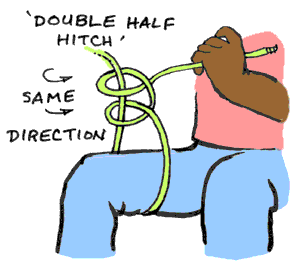The Half Hitch
![]()
![]()
A starter knot
The most basic of knots is called a half hitch. In a slightly different form it's popularly known as an overhand knot, which is the first step to tying shoelaces. The half hitch, though insufficient for most uses by itself, is a necessary building block for most of the other knots.

Step 1: Hold
it
Hold your practice rope in your non-dominant hand. Call the end in
your nondominant hand the working end. Mostly you just want to keep
the working end out of your way.
Now pick up the free end, the end you want to tie, with your dominant hand.
Step 2: Wrap
it
Pass the free end under and around your leg. Pretend that your leg is
an object you need to secure with the rope.
Step 3: Cross it
Take the free end and pull it up
parallel to the working end. Cross the free end over the working end.
Push the free end under the loop created by the cross-over. Pull the
free end to snug down the knot.
To a double half hitch
A double half-hitch is just one of many kinds of hitches. It's great to use for securing rope to an object that you want to hold fast, such as tent stakes and laundry lines. As a bonus, it's easy to tie and untie. Start by tying a half hitch (see above).

Step 1: Hold
it
Take up the free end which should be trailing from the loop of the
half hitch. Pull the free end parallel to the working end. The
working end should be straight.
Step 2: Tie
another half-hitch
Cross the free end over the working end in the same direction as the
first half hitch formed. Pass the free end behind the working end
(notice the new loop you've just formed) and push the free end
through the new loop. Snug down the two loops by pulling on the free
end and the working end (remember--the working end is the one that
passes around your leg).
Step 3: Tighten
it
Pull the knot firmly against the object by sliding the double
half-hitch along the working end of the rope. This knot will also
tighten naturally by pulling on the working end. Notice how the hitch
puts a bend in the rope which prevents it from slipping. This bend in
the rope is called a bight.